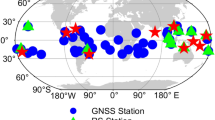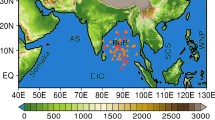Abstract
Moisture sources and transport paths for precipitation are of primary importance for forecasts and early warning, but are rarely studied in the arid region of China. Our study employed the hybrid single-particle Lagrangian integrated trajectory (HYSPLIT) model to investigate and quantify the moisture sources which contributed to a torrential rainfall event on 15–18 July 2007 in the arid Xinjiang region in China. Based on the distribution of torrential rains, the target study region was selected at East Xinjiang (35°N–45°N, 80°E–95°E). The results indicate that moisture sources originating from the south, west, and north branches, and moisture sources in the Atlantic Oceans and Central Asia regions contributed to the East Xinjiang rain event by 37 and 44%, respectively. Our findings match those from diagnostic results of an Eulerian framework model, but the HYSPLIT model provided better quantitative and objective results.








Similar content being viewed by others
References
Bracken C, Rajagopalan B, Alexander M, Gangopadhyay S (2015) Spatial variability of seasonal extreme precipitation in the western United States. J Geophys Res Atmos 120:4522–4533
Brimelow JC, Reuter GW (2005) Transport of atmospheric moisture during three extreme rainfall events over the Mackenzie River basin. J Hydrometeorol 6(4):423–440
Chen Y (2014) Water resources research in Northwest China. Springer Science & Business Media, Berlin
Chen FH, Huang W, Jin LY (2011) Spatiotemporal precipitation variations in the arid Central Asia in the context of global warming. Sci China Earth Sci 54(12):1812–1821
Dee DP (2011) The ERA-Interim reanalysis: configuration and performance of the data assimilation system. Q J R Meteorol Soc 137:553–597
Draxler RR, Hess G (1998) An overview of the HYSPLIT_4 modelling system for trajectories. Aust Meteorol Mag 47(4):295–308
Draxler RR, Rolph GD (2011) HYSPLIT (HYbrid Single-Particle Lagrangian Integrated Trajectory) Model; National Oceanic and Atmospheric Administration, Air Resources Laboratory READY Web site. http://ready.arl.noaa.gov/HYSPLIT.php
Du H, Xia J, Zeng S (2014) Regional frequency analysis of extreme precipitation and its spatio-temporal characteristics in the Huai River Basin, China. Nat Hazards 70(1):195–215
Eagleson PS (1970) Dynamic hydrology. McGraw-Hill, Inc, New York
Fang S, Yan J, Che M, Zhu Y, Liu Z, Pei H, Lin X (2013) Climate change and the ecological responses in Xinjiang, China: model simulations and data analyses. Quat Int 311:108–116
Gustafsson M, Rayner D, Chen D (2010) Extreme rainfall events in southern Sweden: Where does the moisture come from? Tellus Ser A 62(5):605–616
Huang Y, Cui X (2015a) Moisture sources of an extreme precipitation event in Sichuan, China, based on the Lagrangian method. Atmos Sci Lett 16:177–183
Huang Y, Cui X (2015b) Moisture sources of torrential rainfall events in the Sichuan Basin of China during summers of 2009–2013. J Hydrometeorol 16:1906–1917
Huang W, Chen FH, Feng S (2013) Interannual precipitation variations in the mid-latitude Asia and their association with large scale atmospheric circulation. Chin Sci Bull 47(32):3962–3968
Huang W, Feng S, Chen JH (2015) Physical mechanisms of summer precipitation variations in the Tarim Basin in northwestern China. J Clim 28(9):3579–3591
Huang W, Chang SQ, Xie CL, Zhang ZP (2017) Moisture sources of extreme summer precipitation events in North Xinjiang and their relationship with atmospheric circulation. Adv Clim Change Res 8:12–17
Jiang FQ, Zhu C, Mu GJ (2005) Magnification of flood disasters and its relation to regional precipitation and local human activities since the 1980s in Xinjiang, northwestern China. Nat Hazards 36(3):307–330
Jiang Z, Liang Z, Liu Z, Zhu Y (2011) A diagnostic study of water vapor transport and budget during heavy precipitation over the Huaihe River basin in 2007. Chin J Atmos Sci 35:361–372 (in Chinese)
Jiang Z, Ren W, Liu Z, Yang H (2013) Analysis of water vapor transport characteristics during the Meiyu over the Yangtze-Huaihe River valley using the Lagrangian method. Acta Meteorol Sin 71:295–304 (in Chinese)
Jiang Z, Jiang S, Shi Y, Liu Z, Li W, Li L (2017) Impact of moisture source variation on decadal-scale changes of precipitation in North China from 1951 to 2010. J Geophys Res Atmos 122:600–613
Li Y, Sun C (2016) Impacts of the superimposed climate trends on droughts over 1961–2013 in Xinjiang, China. Theor Appl Climatol. https://doi.org/10.1007/s00704-016-1822-x
Li Y, Zhang CQ, Wang Y (2016a) The verification of millennial-scale monsoon water vapor transport channel in northwest China. J Hydrol 536:273–283
Li X, Zhou W, Chen YD (2016b) Detecting the origins of moisture over southeast China: seasonal variation and heavy rainfall. Adv Atmos Sci 33(3):319–329
Liu L, Xu ZX (2016) Regionalization of precipitation and the spatiotemporal distribution of extreme precipitation in southwestern China. Nat Hazards 80:1195–1211
Newell RE, Newell NE, Zhu Y, Scott C (1992) Tropospheric rivers—a pilot-study. Geophys Res Lett 19:2401–2404
Shi YF, Shen YP, Li DL, Zhang GQ, Ding YH, Hu RJ, Kang E (2003) Discussion on the present climate change from warm-dry to warm-wet in northwest China. Quat Sci 23(2):152–164 (in Chinese)
Shi Y, Shen Y, Kang E, Li D, Ding Y, Zhang G, Hu R (2007) Recent and future climate change in northwest China. Clim Change 80(3):379–393
Sodemann H, Schwierz C, Wernli H (2008) Interannual variability of Greenland winter precipitation sources: Lagrangian moisture diagnostic and North Atlantic Oscillation influence. J Geophys Res 113:D03107
Wang MZ, Ren Q, Geng Y, Chai YH (2017) Application of radar wind profiler data in analyzing the process of torrential rains in Urumqi Xinjiang, China. Nat Hazards. https://doi.org/10.1007/s11069-017-2940-1
Xu C, Chen YN, Yang Y, Hao X, Shen Y (2010) Hydrology and water resources variation and its response to regional climate change in Xinjiang. J Geogr Sci 20(4):599–612
Yang LM (2003) Climate change of extreme precipitation in Xinjiang. Acta Geogr Sin 58(4):577–583 (in Chinese)
Yang LM, Zhang YH (2017) Summary of current research on Central Asian vortex. Adv Clim Change Res 8:1–9
Yang H, Jiang Z, Liu Z, Zhang Q (2014) Analysis of climatic characteristics of water vapor transport based on the Lagrangian method: a comparison between Meiyu in the Yangtze-Huaihe River region and the Huabei rainy season. Chin J Atmos Sci 38(5):965–973 (in Chinese)
Yao JQ, Yang Q, Mao WY (2018) Analysis of a summer rainstorm water vapor paths in Tianshan Mountains (Xinjiang) based on HYSPLIT 4 model. Plateau Meteorol 37(1):68–77 (in Chinese)
Yatagai A (2003) Evaluation of hydrological balance and its variability in arid and semi-arid regions of Eurasia from ECMWF 15 year reanalysis. Hydrol Process 17(17):2871–2884
Zeng Y, Yang LM, Zhang YX (2017) Simulation of water vapor transport trajectories of a heavy rain in Western Xinjiang. Desert Oasis Meteorol 11(3):47–54 (in Chinese)
Zhang JB, Deng ZF (1987) Xinjiang precipitation introduction. China Meteorological Press, Beijing (in Chinese)
Zhang DD, Yan DH, Wang YC, Lu F, Liu SH (2015) GAMLSS-based nonstationary modeling of extreme precipitation in Beijing–Tianjin–Hebei region of China. Nat Hazards 77(2):1037–1053
Zhao Y (2014) Impact of the middle and upper troposphere cooling over central Asia on the summer rainfall in the Tarim Basin, China. J Clim 27:4721–4732
Zhao Y, Yu Z, Chen F (2009) Spatial and temporal patterns of Holocene vegetation and climate changes in arid and semi-arid China. Quat Int 194(1):6–18
Acknowledgements
The research is supported by the National Natural Science Foundation of China (41605067), Open Found of State Key Laboratory of Desert and Oasis Ecology, Xinjiang Institute of Ecology and Geography, CAS (G2018-02-02), China Desert Meteorological Science Research Foundation (SQJ2015012), and China Postdoctoral Science Foundation (2016M592915XB). We also thank International Science Editing (http://www.internationalscienceediting.com) for editing this manuscript.
Author information
Authors and Affiliations
Corresponding author
Rights and permissions
About this article
Cite this article
Yao, J., Li, M. & Yang, Q. Moisture sources of a torrential rainfall event in the arid region of East Xinjiang, China, based on a Lagrangian model. Nat Hazards 92 (Suppl 1), 183–195 (2018). https://doi.org/10.1007/s11069-018-3386-9
Received:
Accepted:
Published:
Issue Date:
DOI: https://doi.org/10.1007/s11069-018-3386-9




